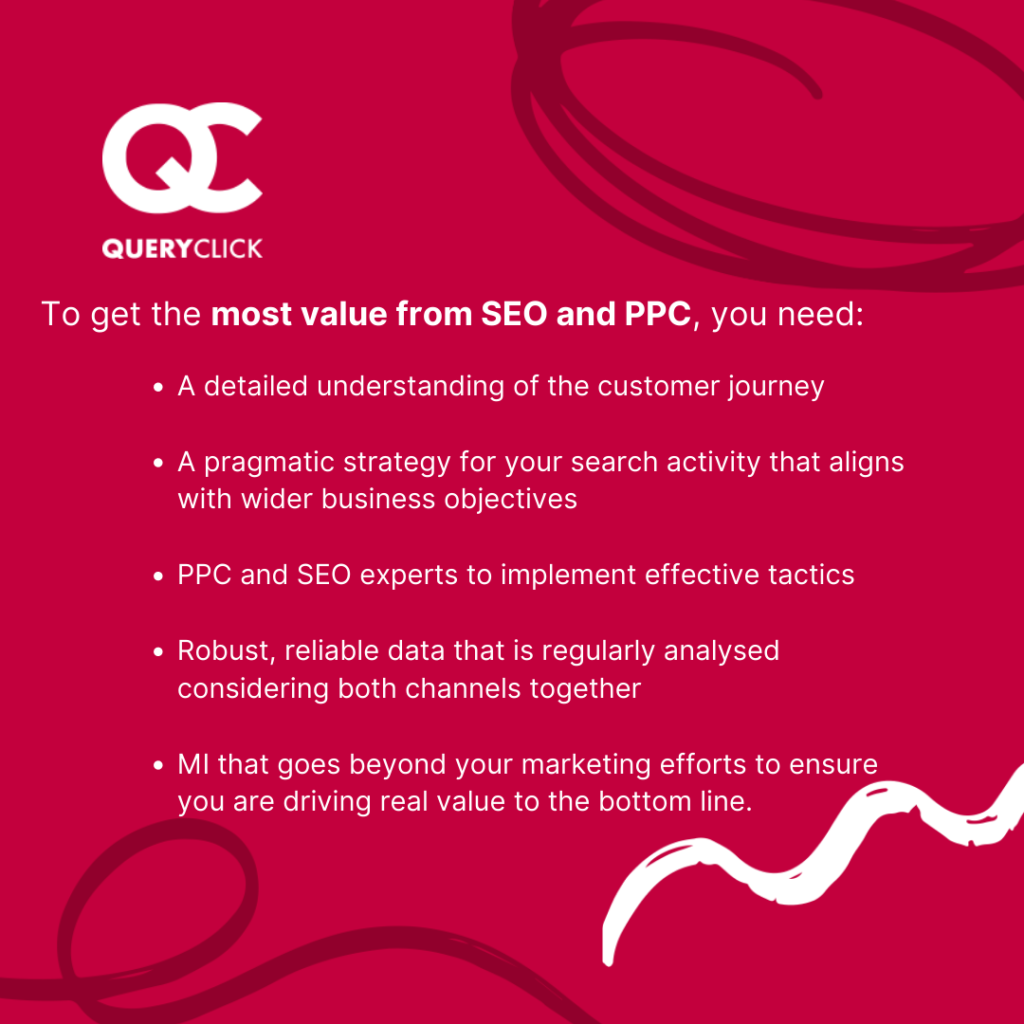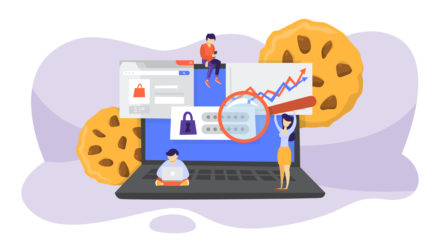Why You Need SEO and PPC to Work Together

A particular scurrilous rumour arises periodically from the depths of online digital marketing communities. Disgruntled webmasters proclaim the organic rankings of sites that invest in PPC are better than those that don’t, and it’s all part of Google’s manipulation of marketing budgets.
This is patently false (and perhaps down to a fundamental misunderstanding of search marketing). Yet the mantra that you need both PPC and SEO to work together to maximise the cumulative performance of these channels remains true.
While distinct tactics are required to perform effectively in each of the channels, allowing them to be siloed and not viewing them as complimentary is a myopic approach that will result in wasted budget and sub-optimal performance. Here we look at why and how you can integrate SEO and PPC make search as a whole work for the best results.
How to Maximise Traffic: Use PPC to Plug Gaps
One of the most obvious ways to ensure your PPC and SEO tactics add up to more than the sum of their parts is by plugging gaps in organic visibility with increased PPC presence.
To illustrate the point, we’ll use the example of a fictional sports shop. Rankings might be great for running and cycling gear, with organic traffic and orders for that section of the site are coming in thick and fast. Well done SEO team! But before socially distanced high-fives all round, what about the areas of the site that don’t have the same visibility?
A reliance on the traffic and revenue from those two categories alone is an inherent risk. If seasonality triggers a drop in demand, competitive factors make your product offering less appealing, SERP layouts change or any of the other myriad of threats in a dynamic trading environment become prominent, your business will suffer.
Here PPC can be used to spread that risk. It can quickly generate traffic to areas of the site that SEO is not performing as well for. So in this instance there may be a PPC focus on other categories where you don’t have first page rankings – golf and tennis equipment for example.
While this should help you generate revenue from a wider variety of categories, it will also widen your customer base which will lead to more opportunities to cross and upsell, as well as generating repeat buys to maximise the lifetime value of your customers.
This approach is particularly useful if you add new categories to your product offering and it takes a while to build the required authority to rank well organically.
This plugging of ranking gaps through PPC won’t necessarily be at category level either. The requirement might be narrower than that, and bidding tactics can be leveraged to ensure that ads appear for a tighter, sub-set of keywords. With our fictional sport shop example, this might be Nike trail running shoes – despite having good overall rankings for running keywords.
How Can SEO Support PPC Budget Efficiency?
If the use of PPC to plug gaps in organic visibility appears as though PPC is covering for a deficiency in SEO performance, the compliment can be returned.
With a finite PPC budget, it’s essential that it’s invested effectively. This can be achieved by reducing the spend on keywords or product categories where SEO performs well.
Doing so allows that saved budget to be invested in more expensive keywords or those that may need a greater focus. Examples of this budget reallocation could be:
- Products or services that have a higher profit margin.
- Areas of the site that attract customers with a higher lifetime value.
- Generate visitors higher in the conversion funnel through more expensive generics.
- Shifting stock where buying departments have invested in a higher number of products.
- Sections of the site where there is low traffic from other channels.

SEO Focus on PPC Budgets
Recently, PPC practitioners have been exposed to the pain once felt by SEOs with a restriction of keyword level data.
Unprovided now dominates organic keyword level data in analytics packages, meaning we cannot see which keywords are generating the most organic revenue. However, much of that data is still available for PPC traffic.
Therefore, SEO’s can optimise pages towards the keywords that convert well through PPC. Equally, keywords with high CPCs that restrict paid ROI can be targeted, allowing budget to be reduced and reinvested elsewhere in the account.
In some areas, it may actually be the case that PPC is canibalising SEO and money is being wasted on attracting traffic that would have arrived for ‘free’ through an organic listing.
While this may be more likely for brand searches, viewing both channels as a partnership and examining the data from both together will allow such wastage to be uncovered and addressed.
At QueryClick, we developed propriety software to address this exact challenge. Universal Search (formerly Halo), which is part of our Corvidae suite, blends SEO and PPC data at a granular level.
This allows us to identify where any channel cannibalisation is taking place or budget inefficiencies lie and reallocate paid budget. This helped us remove £4.5m in spend wastage for AirBnB and over £1 million in spend wastage for Tesco Mobile.
Testing
Driving the highest possible ROI from both SEO and PPC requires maximising the relevant traffic you acquire from the SERPs. This means squeezing out as much traffic as you can from the impressions you generate and taking an integrated approach across both channels.
From the SEO side of things, CTRs from the SERPs are heavily reliant on rankings, but testing the appearance and content of your listing can help drive more traffic and revenue.
For example, in the run up to Christmas last year, we tested different meta descriptions for a client and found that positioning a certain group of products as gifts improved click through rate by a third.
Although, for simple message testing like this PPC generally allows greater control to be exerted.
Ad copy and meta descriptions
With PPC, you can specify the exact copy to be to be displayed (something that is not always possible with meta-descriptions for SEO, as Google may deem other on-page copy more relevant and choose to show that as part of your listing).
You can also apply much greater control over the keywords certain ads appear for and Google Ads even allows you to run A/B tests with ad copy.
The greater control and ease of testing through PPC means the most effective CTAs and other messaging can be identified based on click though, bounce, and conversion rates. The most effective wording can then be applied to meta descriptions.
However, caution is required – just because that wording or messaging was most effective for PPC, it does not guarantee it will generate the same results through SEO.
Consistent vs complimentary messaging

If you have PPC ads on SERPs where organic rankings are strong, you can test hypotheses based on the impact of consistent or different messaging between the two channels.
You can examine whether hammering home a certain message (for example, a USP that blows the competition out the water) is more effective at generating an overall increase in CTR and ROI, or whether complimentary messaging is more effective.
With limited characters available in ad-copy and meta descriptions but both needing to show users that your site will effectively allow them to fulfill the goal of their search, it leaves less space to display additional incentives. An example of complimentary messaging in product-based ecommerce might be to include free delivery messaging in PPC ads and the ability to pay with Klarna in organic listings using the meta description.
To be effectively evaluated, all these tests require analysis of both SEO and PPC data together, so the full impact can be understood. Obviously, each test will have a different hypothesis but the real aim is to improve the value you drive from search as a whole, rather than individual channels as your presence in the SERP through one channel may be impacting the performance of another.
Brand and SERP domination
To some, bidding on your own brand name might seem like KLF-levels of financial prudence. After all, if you rank number one for your brand why would you pay to get those clicks if you could get them through your organic listing without having to give a search engine money for them?
However, there may be many good reasons to have PPC adverts show for brand searches, these include:
- Protecting the space to stop competitors stealing your traffic
- Pushing other web properties that appear in the SERP further down the page
- Routing traffic directly to high value pages through sitelinks – especially if those pages are not showing in organic site links.
Of course, this has a greater impact on mobile, particularly with site links. If there are no shopping ads, your brand listings and site links will take up almost all of the available space in the search results that are above the fold. Therefore, users have to scroll down the page to see any other listings.
Looking at the performance of the channels in isolation, you may find that brand PPC campaigns deliver a much better ROI than other campaigns and assume more money should be invested in it. Naturally, the SEO team would scream about cannibalisation until they are blue in the face if an overarching view of search is not taken.
Equally, if relying on SEO to hoover up all your brand traffic you might find that there is not the desired 100% click through rate from these searches. PPC can be a cost-effective way of eking out a little more traffic from those searches – especially if it they have a high propensity to convert.
The requirement for paid and organic to work together can also get much more complex in different industries and for different brands. In the above, there were certain assumptions made, namely that you have a unique brand name. Things may be different and there may be a greater requirement for brand PPC if you have a similar brand name to another business.
Brand + product
When we consider brand + product searches (i.e. Johnstons of Elgin cashmere cardigans), the dynamic can change again – especially if your brand is a manufacturer that also sells through other outlets.
In that case, you have to look at the bigger picture and go beyond the immediate PPC data. Firstly, you must consider the CPCs for acquiring that traffic and the conversion rates, the cost of fulfilling the sale, and the immediate ROI as well as any potential life time value of those customers. This should be weighed up against the profit generated from wholesale purchases of your product by another vendor, and not just in the short term or at individual product level.
If you are a retailer that stocks multiple-brands, a brand + product, or even your brand + brand you sell search (i.e. schuh adidas trainers) could be disrupted via a competitor that sells the exact same product. Here, PPC may have to be a bit more aggressive as organic may not be taking as high percentage of that traffic as you would like, especially with competitor PPC or shopping ads being displayed in those search results.
Ultimately, you need to ensure that your presence across the search engines is driving the highest amount of profit for the money you spend. Looking at each channel in isolation will not give you a clear picture of this, nor will using a last click attribution model.
Complex journeys demand integration
The journey to conversion is multi-faceted. It is likely that a consumer has multiple interactions with your brand before you reach the holy grail of a sale.
A prospect might first find out about your products or brand through an informational search that leads to a click on an organic listing for one of your blog posts. If they ultimately convert from a brand PPC ad, is it accurate to assign the entire value of that sale to PPC?
Conversely, the first visit to your site might arrive from a click on your PPC ad after a top-level generic product category search. The consumer might like what they see, go away and do some research, then eventually convert from a longtail, product specific search that takes them to an organic listing of a product page. Should you ignore the role PPC played in that sale?
Therefore, you need to ensure that SEO and PPC (as well as other channels) are working together at all stages of the conversion funnel. Search is a powerful tool for generating traffic at every stage of the funnel and failure to have both channels working together on this could result in diminished profit margins. Not just from PPC budget inefficiency but also by neglecting pre-transactional conversion stages and thereby suffering from a diminishing number of people who would consider your brand when making a purchase decision.
Here a cost-per cookie mindset can be adopted. Attracting organic traffic to non-transactional content that targets users in the awareness phase or triggers their perceived need for your products allows you to warm them up to your brand and re-target them through paid channels. Effective measurement of this not only allows you to showcase the value of that content, it also helps drive your multi-channel performance.
Effective attribution
To understand the how well the two search disciplines work together throughout the entire customer journey last click, first click, U shaped, linear and other off-the-shelf attribution models are insufficient. More importantly, they do not allow correct decisions to be made when it comes to budget and resource allocation, as well as strategic prioritisation.
Visit-level attribution is required to truly understand how the disciplines work together. By analysing sessions rather than users, understanding the propensity to convert, and the value of each visit (along with everything that generated that visit) means you can reduce wasted budget and allocate it to the activity that will generate the best returns.
How to make SEO and PPC work together

We’ve covered some of the ways SEO and PPC should work together and why you need them to. To make sure you are getting the best value from the two channels, you need:
- A detailed understanding of the customer journey
- A pragmatic strategy for your search activity that aligns with wider business objectives
- PPC and SEO experts to implement effective tactics
- Robust, reliable data that is regularly analysed considering both channels together
- MI that goes beyond your marketing efforts to ensure you are driving real value to the bottom line.
Want to find out more about how your SEO and PPC can work together for improved results? Get in touch with us today.
Own your marketing data & simplify your tech stack.
Have you read?
Chrome’s announcement on dropping cookie opt-in last month closed the door on a 5 year saga for marketers. But what is the landscape like in 2025 for cookie-based measurement?
Generative AI is transforming the way that marketers plan and assemble content for their Paid Ads. As big platforms like Google, Meta and TikTok increasingly build the tools needed to...
In a surprising move that has sparked heated debate, Mark Zuckerberg announced on his Instagram that Meta will be reducing its levels of censorship and in particular fact-checking on its...



